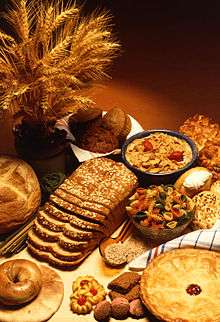Refined grains
Refined grains, in contrast to whole grains, refers to grain products consisting of grains or grain flours that have been significantly modified from their natural composition. The modification process generally involves the mechanical removal of bran and germ,[1] either through grinding or selective sifting. Further refining includes mixing, bleaching, and brominating; additionally, thiamin, riboflavin, niacin, and iron are often added back in to nutritionally enrich the product. Because the added nutrients represent a fraction of the nutrients removed, refined grains are considered nutritionally inferior to whole grains.[2] However, for some grains the removal of fiber coupled with fine grinding results in a slightly higher availability of grain energy for use by the body.[3] Furthermore, in the special case of maize, the process of nixtamalization (a chemical form of refinement) yields a considerable improvement in the bioavailability of niacin, thereby preventing pellagra in diets consisting largely of maize products.
| Wheat | Rice | |||||
|---|---|---|---|---|---|---|
| Whole | Refined | Enriched | Whole | Refined | Enriched | |
| Food energy | 100% | 107% | 107% | 100% | 99% | 99% |
| Carbohydrates | 100% | 105% | 105% | 100% | 104% | 104% |
| Fiber | 100% | 22% | 22% | 100% | 37% | 37% |
| Protein | 100% | 75% | 75% | 100% | 90% | 90% |
| Thiamin (B1) | 100% | 27% | 176% | 100% | 17% | 144% |
| Riboflavin (B2) | 100% | 19% | 230% | 100% | 53% | 53% |
| Niacin (B3) | 100% | 20% | 93% | 100% | 31% | 82% |
| Pantothenic Acid (B5) | 100% | 43% | 43% | 100% | 68% | 68% |
| Pyridoxine (B6) | 100% | 13% | 13% | 100% | 32% | 32% |
| Folate (B9) | 100% | 59% | 350% | 100% | 40% | 1155% |
| Vitamin E | 100% | 5% | 5% | 100% | 18% | 18% |
| Calcium | 100% | 44% | 44% | 100% | 100% | 100% |
| Iron | 100% | 30% | 120% | 100% | 54% | 293% |
| Magnesium | 100% | 16% | 16% | 100% | 17% | 17% |
| Phosphorus | 100% | 31% | 31% | 100% | 35% | 35% |
| Potassium | 100% | 26% | 26% | 100% | 52% | 52% |
| Sodium | 100% | 40% | 40% | 100% | 71% | 71% |
| Zinc | 100% | 24% | 24% | 100% | 29% | 29% |
| Copper | 100% | 38% | 38% | 100% | 79% | 79% |
| Manganese | 100% | 18% | 18% | 100% | 29% | 29% |
| Selenium | 100% | 48% | 48% | 100% | 65% | 65% |
See also
References
- ↑ FDA Provides Guidance on "Whole Grain" for Manufacturers
- ↑ Campbell, Hauser & Hill, Nutritional Characteristics of Organic, Freshly Stone-Ground, Sourdough & Conventional Breads, McGill University, 1991
- ↑ Goodband, Tokach & Nelssen, The Effects of Diet Particle Size on Animal Performance, Kansas State University, 1995
- ↑ USDA Standard Reference 17 Food Nutrient Database

